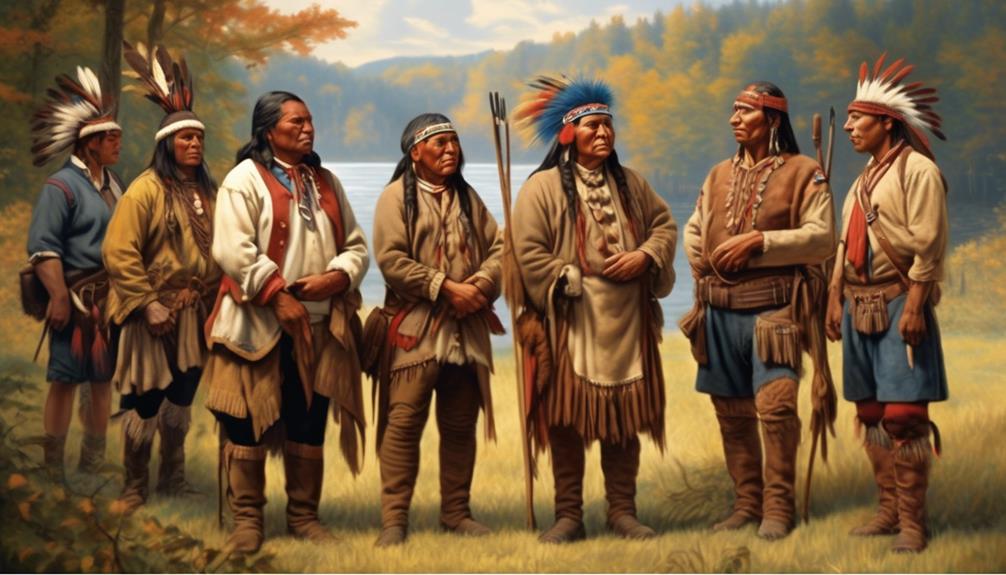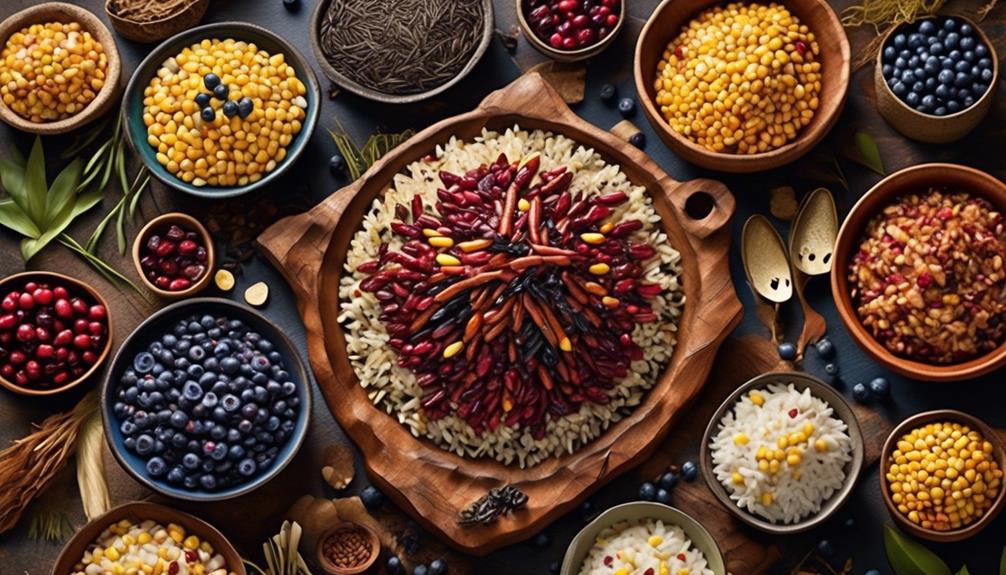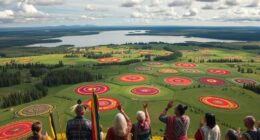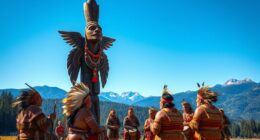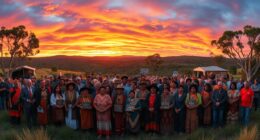Have you ever thought about the presence of Native communities before the Columbian Exchange?
There's a prevailing idea that these communities were isolated and static, but the reality is far more complex. By exploring their social structures, agricultural practices, cultural traditions, trade networks, and environmental stewardship, we can gain a deeper understanding of the vibrant and dynamic societies that existed long before the arrival of European settlers.
Key Takeaways
- Indigenous communities had intricate social structures and governance systems, with leadership roles based on hereditary succession, personal qualities, and demonstrated abilities, and community decision-making through collaborative processes and consensus-building.
- These communities had sustainable agricultural practices and food systems, with intimate knowledge of ecosystems for sustainable techniques, diverse crops and crop rotation for agricultural sustainability, and communal food sharing practices for social bonds and equitable distribution.
- Cultural traditions and spiritual beliefs were deeply ingrained in indigenous communities, with significance given to ceremonial rituals, oral storytelling as a way to preserve cultural knowledge, indigenous artwork reflecting spiritual beliefs, and sacred landscapes with profound spiritual significance.
- Indigenous communities had extensive trade networks and interactions, with trade routes facilitating the exchange of goods and ideas, commodity exchange embedded in spiritual and ceremonial practices, trade networks fostering diplomatic alliances and mutual understanding, and the diffusion of cultural practices and spiritual beliefs through trade.
Social Structures and Governance
Indigenous communities in the Americas developed diverse social structures and governance systems that reflected their unique cultural and environmental contexts. Leadership roles within these societies were often based on a combination of hereditary succession, personal qualities, and demonstrated abilities. Community decision-making was typically a collaborative process, with input from various members, including elders, warriors, and spiritual leaders. Tribal councils played a pivotal role in governance, where important matters were discussed and decisions made through consensus-building.
Social hierarchy within these communities was intricate and multifaceted. While some societies had clear distinctions between classes, others exhibited a more egalitarian structure. Leadership positions often held significant influence, but decisions were commonly made with the input and consent of the broader community.
The role of women in governance varied among different indigenous groups, with some societies affording them substantial influence and others restricting their participation in decision-making processes.
Agricultural Practices and Food Systems
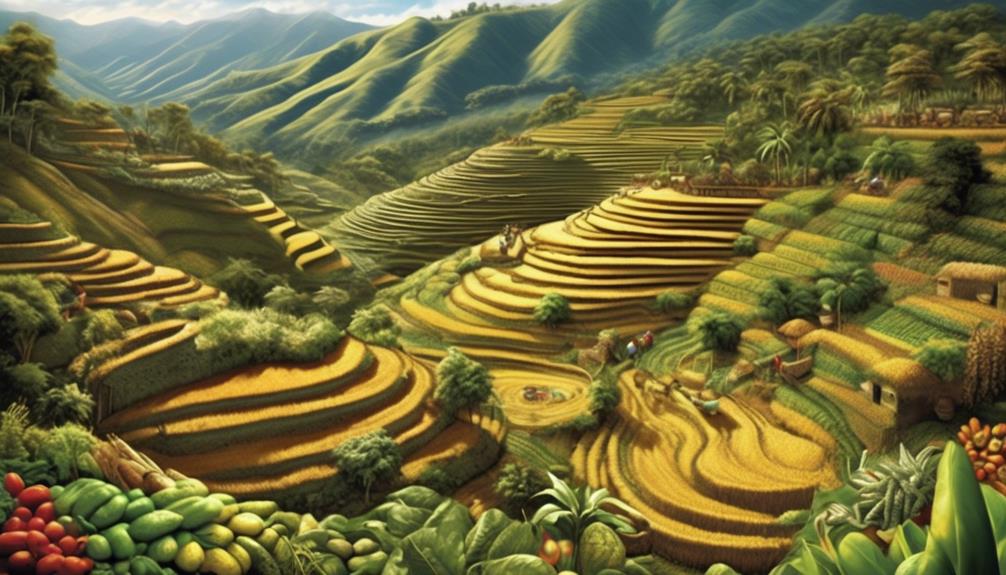
Agricultural practices and food systems in indigenous communities of the Americas were intricately intertwined with their social structures and governance, reflecting a deep connection between human societies and the natural environment.
- Intimate Knowledge of Ecosystems: Indigenous communities had a profound understanding of their local ecosystems, enabling them to develop sustainable agricultural techniques tailored to their specific environments.
- Biodiversity and Crop Rotation: Agricultural sustainability was achieved through the cultivation of diverse crops and the practice of crop rotation, which helped maintain soil fertility and minimize pest damage.
- Traditional Food Preservation Methods: Indigenous cuisine evolution was marked by the development of various food preservation techniques such as drying, smoking, and fermentation, allowing communities to store food for extended periods.
- Communal Food Sharing: The food systems were characterized by communal food sharing practices, reinforcing social bonds and ensuring equitable distribution of food within the community.
Indigenous agricultural practices and food systems weren't only productive but also deeply rooted in sustainable and holistic approaches that respected the natural world. The evolution of indigenous cuisine was a testament to the innovative ways in which these communities adapted to and thrived within their diverse ecosystems.
Cultural Traditions and Spiritual Beliefs
Cultural traditions and spiritual beliefs among the indigenous communities of the Americas were integral components of their societal fabric, shaping their worldview and guiding their interactions with the natural and supernatural realms.
Ceremonial rituals held great significance, often marking important events such as harvests, solstices, or rites of passage. These rituals were deeply rooted in the belief systems of the communities, connecting them to their ancestors and the spiritual forces they revered.
Oral storytelling played a vital role in preserving and passing down cultural knowledge, history, and spiritual teachings from one generation to the next. Through these narratives, the indigenous peoples upheld their traditions and conveyed the wisdom of their elders.
Indigenous artwork also reflected spiritual beliefs, often intertwining with ceremonial practices and serving as expressions of cultural identity.
Additionally, sacred landscapes held profound spiritual significance, with certain geographical features being revered as portals to the supernatural or as embodiments of divine entities.
The intricate interplay of ceremonial rituals, oral storytelling, indigenous artwork, and sacred landscapes underscored the richness and depth of indigenous cultural and spiritual traditions before the Columbian Exchange.
Trade Networks and Interactions
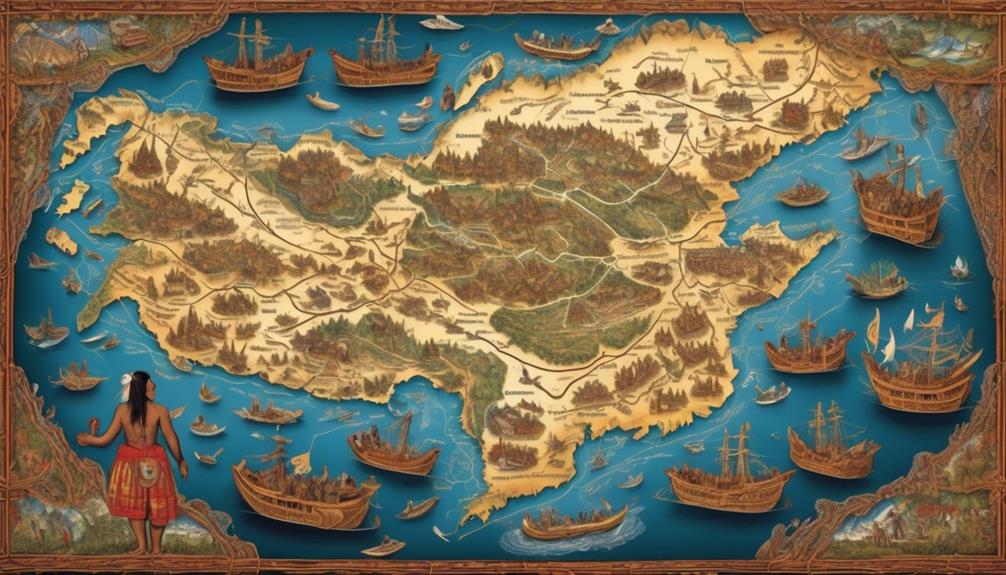
As we explore the intricate web of interactions and exchange, it becomes evident that the cultural traditions and spiritual beliefs of indigenous communities played a crucial role in shaping their participation in trade networks. The dynamics of cross-cultural exchanges and economic relationships were influenced by the belief systems and material needs of the indigenous communities. Intertribal trade and diplomatic relations were structured around kinship networks and alliances, reflecting the interconnectedness of indigenous societies.
Here are four key aspects to consider:
- Trade Routes: Indigenous communities established extensive trade routes that facilitated the exchange of goods and ideas across vast geographical regions. These trade routes often intersected with diplomatic and ceremonial centers, further emphasizing the significance of trade in shaping intertribal relations.
- Commodity Exchange: The exchange of commodities wasn't merely a transactional activity but was deeply embedded in spiritual and ceremonial practices. The transfer of goods often symbolized alliances, peace agreements, and the honoring of spiritual beliefs.
- Diplomatic Alliances: Economic relationships were closely intertwined with diplomatic alliances, where trade acted as a mechanism for solidifying and maintaining intertribal relationships. The flow of goods was often accompanied by the exchange of knowledge and cultural practices, fostering mutual understanding and cooperation.
- Cultural Influence: Trade networks weren't only conduits for the exchange of material goods but also served as channels for the diffusion of cultural practices, traditions, and spiritual beliefs, contributing to the rich tapestry of indigenous societies.
These aspects collectively demonstrate the intricate and multifaceted nature of trade networks and interactions among indigenous communities before the Columbian Exchange.
Environmental Stewardship and Sustainability
Indigenous communities demonstrated a deep commitment to preserving and nurturing their natural surroundings, embodying a holistic approach to environmental stewardship and sustainability. Resource management and conservation were integral parts of their societal structure, ensuring the sustainable use of natural resources for future generations. Ecological balance and harmony were central to their cultural and spiritual beliefs, driving their practices of land and wildlife conservation. This deep connection to the environment allowed indigenous communities to thrive in diverse ecosystems while maintaining a delicate balance between human activities and nature.
| Resource Management | Conservation | Ecological Balance | Harmony |
|---|---|---|---|
| Sustainable practices | Preservation | Biodiversity | Spiritual beliefs |
| Land use strategies | Natural resource use | Ecosystem health | Community values |
| Long-term sustainability | Wildlife protection | Interconnectedness | Environmental ethics |
This table illustrates the multifaceted approach of indigenous communities towards environmental stewardship. They employed sustainable practices, preserved biodiversity, and maintained ecosystem health, guided by their spiritual beliefs and community values. By incorporating these principles into their daily lives, indigenous communities established a harmonious relationship with the environment, setting an example of responsible resource management for the modern world to learn from.
Frequently Asked Questions
How Did Indigenous Communities Navigate and Communicate Across Vast Territories Before the Columbian Exchange?
Before the Columbian Exchange, indigenous communities utilized various communication methods and trade routes to navigate vast territories. Tribal diplomacy played a crucial role in facilitating cultural exchange and maintaining peaceful relations.
Through intricate networks of messengers, runners, and signal systems, they exchanged information, goods, and ideas across long distances. This allowed for the establishment of interconnected trade routes and the dissemination of cultural practices, contributing to the rich tapestry of indigenous societies.
What Role Did Gender and Age Play in the Social Structures and Governance of Indigenous Communities?
Gender roles and age hierarchy were integral to indigenous community governance. Women often held significant influence, with some societies being matrilineal.
Additionally, elders were revered for their wisdom and leadership. A striking fact is that in certain indigenous cultures, women held positions of power and respect, challenging traditional gender dynamics.
These historical examples highlight the complexity and diversity of indigenous social structures, enriching our understanding of pre-Columbian societies.
What Were the Traditional Methods of Food Preservation and Storage Used by Indigenous Communities?
Before the Columbian Exchange, indigenous communities utilized traditional preservation and storage methods for food. Indigenous food storage techniques included drying, smoking, and fermenting to preserve food for longer periods. Additionally, they used various natural resources like salt, sun, and wind for food preservation.
These techniques were crucial for ensuring a stable food supply throughout the year and played a vital role in sustaining indigenous communities.
How Did Indigenous Communities View the Concept of Property and Land Ownership?
When considering the concept of communal ownership, indigenous communities held a deep spiritual connection to the land. This bond was central to their understanding of property and land.
The interconnectedness of their lives with the natural world fostered a shared stewardship of the land. This communal ownership reflected their belief that the land was a living entity, to be respected and cared for by all members of the community.
What Were the Rituals and Ceremonies Associated With Trade and Interactions Between Different Indigenous Communities?
Trade rituals and cultural interactions were integral to the fabric of indigenous societies. Ceremonial exchanges fostered cross-cultural trade, creating networks for sharing goods and ideas. These rituals were often accompanied by elaborate ceremonies, reinforcing social bonds and establishing protocols for trade.
The interactions weren't solely economic; they also held deep spiritual and social significance, contributing to the cohesion and resilience of indigenous communities.
Conclusion
In conclusion, indigenous communities before the Columbian Exchange were diverse and complex, with advanced social structures, sustainable agricultural practices, rich cultural traditions, and interconnected trade networks.
One might argue that these communities were isolated and technologically primitive, but in reality, they'd thriving societies with sophisticated knowledge and practices that sustained their communities for generations.
Understanding the richness of indigenous cultures before European contact is essential for a more comprehensive historical perspective.



